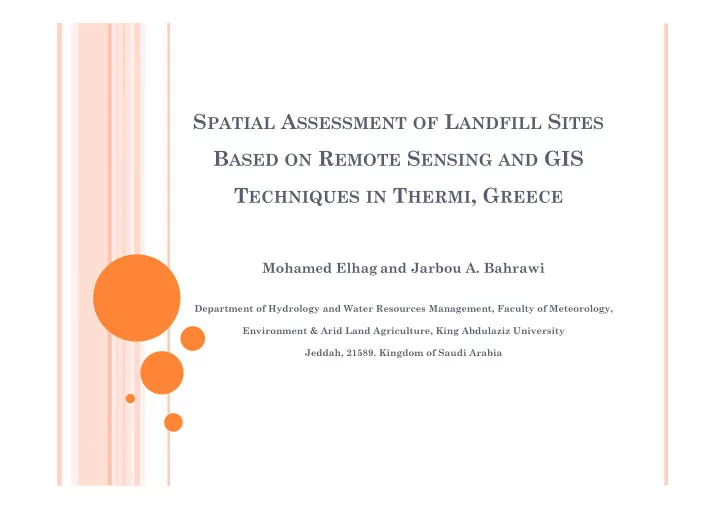

S PATIAL A SSESSMENT OF L ANDFILL S ITES B ASED ON R EMOTE S ENSING AND GIS T ECHNIQUES IN T HERMI , G REECE Mohamed Elhag and Jarbou A. Bahrawi Department of Hydrology and Water Resources Management, Faculty of Meteorology, Environment & Arid Land Agriculture, King Abdulaziz University Jeddah, 21589. Kingdom of Saudi Arabia
P ROBLEM STATEMENT Landfilling is the lowest ranking waste management option in the waste hierarchy, but remains dominant method used in Europe. landfill site selection analyses have been carried out since the end of the last century but problem is still addressed by the literature related to waste management. Landfill siting is one complex spatial problem because its solution requires large amount of environmental, social, economic and engineering data.
S TUDY OBJECTIVES The aim of the current research is to contribute towards wider application of the Geographic Information System and Remote Sensing techniques in the country by presenting their significant helpfulness in solving one specific spatial problem locating a landfill.
S TUDY AREA Study area is located in Thermi municipality in the vicinity of the villages Tagarades, Trilofos, and Agia Paraskevi, prefecture of Thessaloniki, in North Greece.
S ITE SIGNIFICANCE The landfill serves more than 1 million people from the broader area of Thessaloniki city. The waste load of the landfill is 1.368 tn/day. Lately, a firebreak took place and almost of 1500 m 3 of leachates then were released into a local stream network. The contaminated areas are principally used for agricultural activities.
I NPUT D ATASET Four topographic maps were registered and georeferenced to the GCS WGS 1984. Topographic maps in the scale of 1:25.000. Landsat 8 satellite imagery was acquired on June 2013. Digitizing a scanned paper geological map in scale 1:100 000. CORINE Land Cover 2006 data set was used to reclassify the existing land cover.
A PPLIED CRITERIA Constraints Excluding aquifers, groundwater protection zones, watersheds and alluvial plains Excluding national parks, historical areas, habitats of threatened and endangered species 1000 m buffer around intermittent or permanent streams, water bodies and wetlands 5000 m distance from utility corridors (electrical, water, sewer and communication) 2500 m distance from schools, hospitals, churches Factors Landfill site with 50 ha surface (30 to 50 years life span) 1000 m distance from motorways, city streets, residential area, and sensitive area Geological structure of the study area (classified) 6000 m distance from archaeological sites Outside areas with more than 30 % slope
M ETHODOLOGICAL FRAMEWORK Factor Function Constraint Boolean Landfill size Linear scale Used/free potential Land use X according to suitability properties Reclassify into different classes Conversion X 65 0 Study area geo-soil Reclassify Boolean map Slope X Fuzzy sigmoidal River distance X Permanent LU Vegetation Linear scale X X Overlay Suitability map Fuzzy sigmoidal DEM X Threshold Most desirable suitability map
F UZZY FUNCTIONS Linear function Sigmoidal function Trapezoidal function
RECLASSIFIED PARAMETERS Elevation classes Elevation (m) Class Suitability Area (ha) Total area in % < 600 1 Least 7092 79.72 suitable > 600 and < 629 2 More 1651.52 18.56 suitable > 629 and < 726 3 Most 152.96 1.72 suitable
RECLASSIFIED PARAMETERS Slope classes Slope (%) Class Suitability > 20 % < 32 % 0 Excluded area > 15 % < 20 % 1 Least suitable area > 5 % < 15 % 2 More suitable area < 5 % 3 Most suitable area
RECLASSIFIED PARAMETERS Geological classes Deposits Class Suitability Area Total area (ha) in % Diluvium-proluvial 1 Unsuitable 368.16 4.1 Alluvium More 2 8114.4 91.2 suitable Quartz-sericite schist, muscovite chlorite schist and amphibole schist; Most Graphite schist and 416.64 3 suitable 4.7 quartz-muscovite schist; Epidote-chlorite schist and amphibole schist; Mica schist and lepidolite.
RECLASSIFIED PARAMETERS Land cover classes Land cover Class Suitability Area Total area in (ha) % Non-irrigated arable land; 1 Unsuitable 7425.12 83.5 Permanently irrigated land. Broad-leaved forest; Complex cultivation patterns; Land principally occupied by agriculture, with significant 2 More suitable 1079.04 12.1 areas of natural vegetation; Pastures Discontinuous urban fabric; Transitional woodland-shrub. 3 Most suitable 396 4.4
R ESULTS Factors suitability Factors Classified or buffered Land cover – classified Classified 1 - 3 Geology – classified Classified 1 - 3 DEM – classified Classified 1 - 3 Slope - classified Classified 1 - 3 Commercial buildings 1000 m buffer Manufacturing buildings 1000 m buffer Industrial area 1000 m buffer Local roads (connecting 1000 m buffer villages) Path - buffered 1000 m buffer Undefined roads 1000 m buffer
R ESULTS Constraints suitability Constraints Buffered Regional roads 1000 m buffer Channel – up to 5 m wide 5000 m buffer Channel – 5 to 10 m wide 5000 m buffer Channel – over 10 m wide 5000 m buffer Wells 5000 m buffer Piped wells 5000 m buffer Water bodies 5000 m buffer Water pumps 5000 m buffer Permanent stream 5000 m buffer Intermittent stream 5000 m buffer Local roads – inside the village 1000 m buffer Schools 1000 m buffer Residential area 1000 m buffer Villages 1000 m buffer
R ESULTS Weighted overlay resulting classification Description Class Area (ha) Total area in % Unsuitable 0 2614.88 29.39 More suitable 1 366.56 4.12 Most suitable 2 47.82 0.53
R ESULTS Weighted overlay - resulting map (masked) of the study area
R ESULTS Suitable areas for landfill sites in study area
CONCLUSIONS The findings suggested the optimal landfill location based on the least negative environmental impacts. It represent the elementary steps the environmental cost for optimizing a landfill location economically and socially. Examining the differences between a financially and economically optimized landfill location and a landfill location that is the most environmentally sound would also bring out the advantages and disadvantages of both locations.
Recommend
More recommend